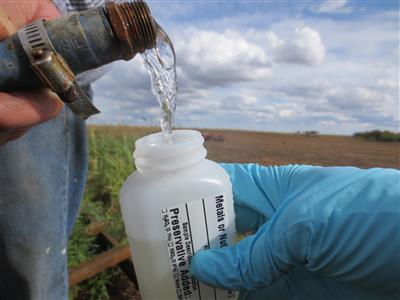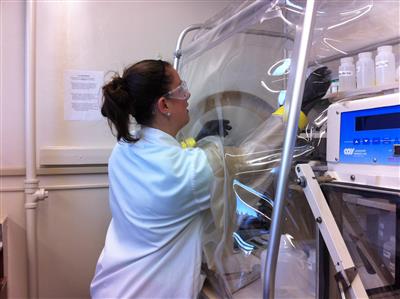
Credit: Patrick Gorski
October 10, 2013
By Aaron R. Conklin
The Wisconsin State Journal headline certainly made it sound unsettling: “Tests Show Madison Water Has High Levels of Chromium-6, but Below Fed Limits.”
That newspaper story, based on a 2011 report by the Environmental Working Group, had Wisconsin residents who failed to read the part after the comma convinced they had an Erin Brockovich-sized environmental catastrophe in their kitchen taps. That wasn’t the case—as the headline noted, even the highest measurements collected from Madison wells were well under the federal 100 µg/L safety limits for the carcinogenic metal—but it did raise concerns. And for Patrick Gorski, the head of inorganic chemistry at the Wisconsin State Lab of Hygiene, it served as the impetus for a fascinating research project.
Using funding administered through the University of Wisconsin Water Resources Institute (WRI), Gorski, along with a team of researchers that includes metals expert Martin Shafer and WRI director Jim Hurley, has spent the past year trying to determine the factors that determine the natural concentration of hexavalent chromium, or Chromium VI, in Wisconsin groundwater.
“We knew it most likely wasn’t due to industrial contamination,” said Gorski of the Madison well readings. “And that made us think that it was probably occurring naturally. But if it’s natural, the question becomes, how does it occur? In what types of groundwater does it occur and what influences it?”
The research team began by identifying several key geological formations in Wisconsin where a confluence of geology and environment could create an ideal situation for the formation of chromium VI. Working with the Wisconsin Department of Natural Resources and the Wisconsin Geological and Natural History Survey, Gorski’s team collected rock and water samples from replacement wells and brought them back to the lab, where reactor experiments were conducted to mimic what was happening in the environment. Factors like the concentration of oxygen—a force that turns the beneficial Chromium III into the potentially dangerous Chromium VI—were examined, as were levels of pH and the presence of other metals like iron and manganese in the surrounding water. In the latest round of experiments, Gorski’s team observed a slight increase in Chromium VI in the presence of the reactors.
“We think we have a good link between geology and water,” said Gorski. “But just because chromium is in the rocks doesn’t mean chromium VI is in the water.”

Credit: Elizabeth Tomaszewski
Over the next year, Zana Sijan, a graduate student pursuing a master’s degree in environmental chemistry, will continue to conduct reactor experiments on the samples, using a glovebox to maintain an anoxic environment.
In doing so, she may also be breaking new ground. Currently, the Environmental Protection Agency (EPA) measurements include all types of chromium, even though not every type is toxic. Specific analytic techniques to measure chromium VI are still being developed and refined. In this sense, Gorski and Sijan could be writing the measurement guide other scientists will use to track the metal in their own states. It’s even possible that Gorski’s team will end up detailing the mechanics of how chromium VI enters the water cycle before the EPA has even developed a clear set of guidelines specific to it.
“Our goal is to develop predictive capabilities,” he explained. “Where in the state could there be the potential for higher levels of hexavalent chromium?”
Eventually, Gorski hopes their findings could be used to help develop guidelines similar to what’s been done with arsenic, where well drillers in Wisconsin know where and how deep to drill to avoid encountering it, as well as which types of well casings to use.
“Having this type of research will benefit us now, and benefit us later,” said Gorski.



